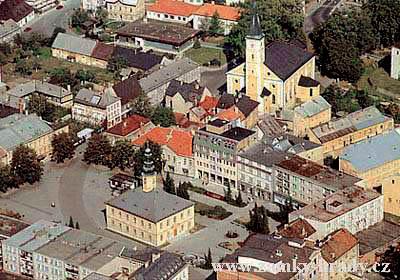Jeseník
 Informační centrum, 790 01 Jeseník
Informační centrum, 790 01 Jeseník
e-mail: jiri.koranda@mujes.cz

Important dates in the History of Jeseník
1267 - The first written record in which the town is referred to as "frei vom Walde" or in English "free from forest". The mining of precious metals is also noted around this time.
Early 1500's - Town is purchased by the Fugger family from Augsburg and experiences its most prosperous period of mining.
1506 - Bishop Jan Turzo grants the town the right to use the coat of arms depicting a Silesian spread eagle and a brown bear on green grass.
1547 - After the gold mines are depleted, the Fugger family is sold back to the Bishops of Breslau (Wroclaw).
1622-1684 - Following the defeat of the Czech Protestant nobility in 1621 to the German Catholics, inquisition trials begin where people, mostly women, are accused of witchcraft and burned alive as a means to weed out remnant Protestants.
1742 - As a result of the "Wroclaw Peace", Silesia is divided into Prussian and Austrian parts. This event has a negative impact on industrial development.
Early 1800's - Rise of the spa industry as Vincenz Priessnitz (1799-1851) develops the first hydropathic institution in the world.
1881 - Moravian-Silesian Sudeten Mountain Association is founded and proceed to develop tourism in the area by building mountain chalets and observation towers in the Jeseníky mountains.
1888 - Hanušovice- Glucholazy railway line is opened, providing better access to a larger area.
1918 - Founding of the Czechoslovak Republic brings increased immigration of Czechs into the region.
1938 - Jeseníky region is annexed by Nazi Germany.
1945 - End of WW II as Russia occupies Czechoslovakia resulting in the migration of Sudeten Germans from the Jeseníky region to Germany and the immigration of Czech, Slovaks, Greeks and Ukrainians to the Jeseníky region.
1996 - the Jeseník District, as an administration unit, is re-established after 36 years

 Informační centrum, 790 01 Jeseník
Informační centrum, 790 01 Jeseník Informační centrum, 790 01 Jeseník
Informační centrum, 790 01 Jeseník
